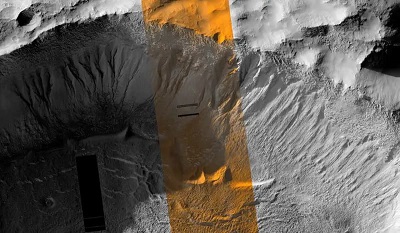New York, (Asian independent) Researchers have found new insights into how water from melting ice could have played a recent role in the formation of ravine-like channels or gullies that cut down the sides of impact craters on Mars.
The study, published in the journal Science, focuses on Martian gullies, which look eerily similar to gullies that form on Earth in the dry valleys of Antarctica and are caused by water erosion from melting glaciers.
The researchers, including from Brown University, built a model that simulates a sweet spot for when conditions on Mars allow the planet to warm above freezing temperatures, leading to periods of liquid water on Mars when ice on and beneath the surface melts.
The scientists found that when Mars tilts on its axis to 35 degrees, the atmosphere becomes dense enough for brief episodes of melting to occur at gully locations.
They then matched the data from their model to periods in Mars history when the gullies in the planet’s Terra Sirenum region are believed to have expanded rapidly downhill from high elevation points — a phenomenon that could not be explained without the occasional presence of water.
“We know from a lot of our research and other people’s research that early on in Mars history, there was running water on the surface with valley networks and lakes,” said Jim Head, a planetary scientist and professor of geological sciences at Brown.
“But about 3 billion years ago, all of that liquid water was lost, and Mars became what we call a hyper-arid or polar desert. We show here that even after that and in the recent past, when Mars’ axis tilts to 35 degrees, it heats up sufficiently to melt snow and ice, bringing liquid water back until temperatures drop and it freezes again,” he added.
The findings help fill in some of the missing gaps on how these gullies formed, including how high they start, how severe the erosion is and how far they extend down the side of craters.
The results from the new study suggest that gully formation was driven by periods of melting ice and by carbon dioxide frost evaporation in other parts of the year.
The researchers found this has likely occurred repeatedly over the past several million years with the most recent occurrence about 630,000 years ago.
They said that if ice was present at gully locations in the areas they looked at when Mars’ axis tilted to about 35 degrees, the conditions would have been right for the ice to melt because temperatures rose above 273 degrees Kelvin, equivalent to about 32 degrees Fahrenheit.
“Our study shows that the global distribution of gullies is better explained by liquid water over the last million years,” said Jay Dickson, the study’s lead author and a former researcher at Brown who’s now at California Institute of Technology.
“Water explains the elevation distribution of gullies in ways that CO2 cannot. This means that Mars has been able to create liquid water in enough volume to erode channels within the last million years, which is very recent on the scale of Mars geologic history.”
The paper raises anew the fundamental question of whether life could exist on Mars. This is because life, as it’s known on Earth, goes hand in hand with the presence of liquid water. Mars will eventually tilt to 35 degrees again, the researchers said.








